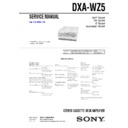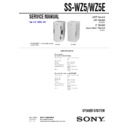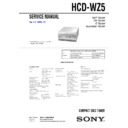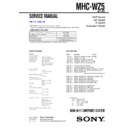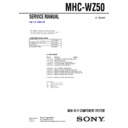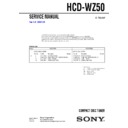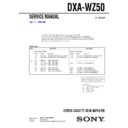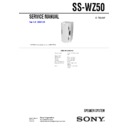Read Sony DXA-WZ5 / DXA-WZ50 / MHC-WZ5 Service Manual online
DXA-WZ5
AEP Model
UK Model
E Model
Australian Model
SERVICE MANUAL
STEREO CASSETTE DECK AMPLIFIER
SPECIFICATIONS
Ver 1.0 2003. 04
• DXA-WZ5 is deck and amplifier
section in MHC-WZ5.
Amplifier section
European model:
European model:
DIN power output (rated): 75 + 75 watts (6 ohms at
1 kHz, DIN)
Continuous RMS power output (reference):
100 + 100 watts (6 ohms
at 1 kHz, 10% THD)
at 1 kHz, 10% THD)
at
at
1 kHz, 10% THD)
at 1 kHz, 10% THD)
Music power output (reference):
200 + 200 watts (6 ohms
The following measured at AC 120, 220, 240 V AC,
50/60 Hz (Australian model at 240 V AC, 50/60 Hz)
DIN power output (rated): 100 + 100 watts (6 ohms
50/60 Hz (Australian model at 240 V AC, 50/60 Hz)
DIN power output (rated): 100 + 100 watts (6 ohms
1 kHz, DIN)
Continuous RMS power output (reference):
140 + 140 watts (6 ohms
Inputs
MD (VIDEO) IN (phono jacks):
MD (VIDEO) IN (phono jacks):
Voltage 450 mV/250 mV,
impedance 47 kilohms
impedance 47 kilohms
Outputs
PHONES (stereo mini jack):
PHONES (stereo mini jack):
Accepts headphones of
8 ohms or more
8 ohms or more
MD (VIDEO) OUT (phono jacks):
Voltage 250 mV,
impedance 1 kilohms
impedance 1 kilohms
FRONT SPEAKER:
Use only the supplied
speaker SS-WZ5/WZ5E
speaker SS-WZ5/WZ5E
SUB WOOFER (Except for European model):
Voltage 320mV,
impedance 1 kilohms
impedance 1 kilohms
Tape deck section
Except for European model:
Recording system
4-track 2-channel, stereo
Frequency response
50 – 13,000 Hz (
±3 dB),
using Sony TYPE I
cassettes
cassettes
General
Power requirements
European model:
European model:
230 V AC, 50/60 Hz
Australian model:
230 – 240 V AC, 50/60 Hz
TW model:
120 V AC, 50/60 Hz
Other models:
120 V, 220 V or
230 – 240 V AC, 50/60 Hz
Adjustable with voltage
selector
230 – 240 V AC, 50/60 Hz
Adjustable with voltage
selector
Power consumption
European model:
European model:
150 watts
0.3 watts (at the Power
Saving Mode)
0.3 watts (at the Power
Saving Mode)
Except for European model:
180 watts
Dimensions (w/h/d)
Amplifier/Tape deck:
Amplifier/Tape deck:
Amplifier/Tape deck
Approx. 255
× 135 ×
330 mm
Mass
European model:
Approx. 6.0 kg
Except for European model:
Approx. 6.3 kg
Design and specifications are subject to change
without notice.
without notice.
Sony Corporation
Home Audio Company
Published by Sony Engineering Corporation
9-877-330-01
2003D1600-1
© 2003.04
Tape deck
Section
Model Name Using Similar Mechanism
NEW
Tape Transport Mechanism Type
CWM43RR23
2
DXA-WZ5
SAFETY-RELATED COMPONENT WARNING!!
COMPONENTS IDENTIFIED BY MARK
0
OR DOTTED LINE WITH
MARK
0
ON THE SCHEMATIC DIAGRAMS AND IN THE PARTS
LIST ARE CRITICAL TO SAFE OPERATION. REPLACE THESE
COMPONENTS WITH SONY PARTS WHOSE PART NUMBERS
APPEAR AS SHOWN IN THIS MANUAL OR IN SUPPLEMENTS
PUBLISHED BY SONY.
COMPONENTS WITH SONY PARTS WHOSE PART NUMBERS
APPEAR AS SHOWN IN THIS MANUAL OR IN SUPPLEMENTS
PUBLISHED BY SONY.
Notes on chip component replacement
• Never reuse a disconnected chip component.
• Notice that the minus side of a tantalum capacitor may be
• Notice that the minus side of a tantalum capacitor may be
damaged by heat.
Flexible Circuit Board Repairing
• Keep the temperature of soldering iron around 270˚C
during repairing.
• Do not touch the soldering iron on the same conductor of the
circuit board (within 3 times).
• Be careful not to apply force on the conductor when soldering
or unsoldering.
TABLE OF CONTENTS
MODEL IDENTIFICATION
— BACK PANEL —
• Abbreviation
AUS
: Australian model
E2
: 120V AC Area in E model
E3
: 240V AC Area in E model
KR
: Korean model
TW
: Taiwan model
PARTS No.
VOLTAGE SELECTOR Switch
Power Voltage Indication
1. GENERAL
·········································································· 3
2. DISASSEMBLY
························································· 5
2-1. Case ··············································································· 5
2-2. Switching Power, DC Fan, Back Panel ························· 6
2-3. MAIN Board ································································· 6
2-4. AMP Board ··································································· 7
2-5. Front Panel Assy ···························································· 7
2-6. Tape mechanism deck (CWM43RR23) ························ 8
2-7. Lid (TC) Assy, Holder (A) Assy, Holder (B) Assy ········ 8
2-2. Switching Power, DC Fan, Back Panel ························· 6
2-3. MAIN Board ································································· 6
2-4. AMP Board ··································································· 7
2-5. Front Panel Assy ···························································· 7
2-6. Tape mechanism deck (CWM43RR23) ························ 8
2-7. Lid (TC) Assy, Holder (A) Assy, Holder (B) Assy ········ 8
3. ELECTRICAL ADJUSTMENTS
································· 9
4. DIAGRAMS
······································································ 10
4-1. Block Diagrams - Main Section - ································ 11
4-2. Printed Wiring Board - MAIN Board - ······················· 12
4-3. Schematic Diagram - MAIN Board (1/2) - ················· 13
4-2. Printed Wiring Board - MAIN Board - ······················· 12
4-3. Schematic Diagram - MAIN Board (1/2) - ················· 13
- MAIN Board (2/2) - ················· 14
4-4. Printed Wiring Board - AMP Board - ·························· 15
4-5. Schematic Diagram - AMP Board - ···························· 16
4-5. Schematic Diagram - AMP Board - ···························· 16
5. EXPLODED VIEWS
5-1. Front Panel Section ····················································· 17
5-2. Chassis Section ···························································· 18
5-3. Tape Mechanism Deck Section ··································· 19
5-2. Chassis Section ···························································· 18
5-3. Tape Mechanism Deck Section ··································· 19
6. ELECTRICAL PARTS LIST
······································· 20
Unleaded solder
Boards requiring use of unleaded solder are printed with the lead-
free mark (LF) indicating the solder contains no lead.
(Caution: Some printed circuit boards may not come printed with
the lead free mark due to their particular size.)
free mark (LF) indicating the solder contains no lead.
(Caution: Some printed circuit boards may not come printed with
the lead free mark due to their particular size.)
: LEAD FREE MARK
Unleaded solder has the following characteristics.
• Unleaded solder melts at a temperature about 40
• Unleaded solder melts at a temperature about 40
°
C higher than
ordinary solder.
Ordinary soldering irons can be used but the iron tip has to be
applied to the solder joint for a slightly longer time.
Soldering irons using a temperature regulator should be set to
about 350
Ordinary soldering irons can be used but the iron tip has to be
applied to the solder joint for a slightly longer time.
Soldering irons using a temperature regulator should be set to
about 350
°
C.
Caution: The printed pattern (copper foil) may peel away if the
heated tip is applied for too long, so be careful!
heated tip is applied for too long, so be careful!
• Strong viscosity
Unleaded solder is more viscous (sticky, less prone to flow) than
ordinary solder so use caution not to let solder bridges occur such
as on IC pins, etc.
ordinary solder so use caution not to let solder bridges occur such
as on IC pins, etc.
• Usable with ordinary solder
It is best to use only unleaded solder but unleaded solder may
also be added to ordinary solder.
also be added to ordinary solder.
[When bringing in the equipment for service]
In case of repairing, please bring the entire system set([HCD-WZ5,
DXA-WZ5],except for the speaker) to the service station.
DXA-WZ5],except for the speaker) to the service station.
MODEL
AEP, UK models
E2 model
E3 model
AUS model
KR model
TW model
PARTS No.
4-244-468-0
s
4-244-468-1
s
4-244-468-1
s
4-244-468-3
s
4-244-468-9
s
4-244-468-8
s
POWER VOLTAGE INDICATION
AC: 230V
50/60HZ
AC: 120V
60HZ
AC: 240V
50HZ
AC: 230-240V
50/60HZ
AC: 220V
50/60HZ
AC: 120V
50/60HZ
3
DXA-WZ5
This section is extracted
from instruction manual.
from instruction manual.
SECTION 1
GENERAL
Main unit
Deck A wh
Deck B wd
A Z (eject) wg (15)
Z B (eject) wf (15)
Z B (eject) wf (15)
ALPHABETICAL ORDER
A – L
BUTTON DESCRIPTIONS
Amplifier Tape deck
4
DXA-WZ5
Perform the following procedures 1 to 5 to hook up your system using the supplied cords and
accessories. Australian model is used for illustration purpose.
accessories. Australian model is used for illustration purpose.
Preparation
Place the components as shown below.
1
Connect the system control cables to
the SYSTEM CONTROL connectors on
the tape deck.
the SYSTEM CONTROL connectors on
the tape deck.
Connect to the same numbered jack in the
order indicated on the rear panel.
order indicated on the rear panel.
Note
The system cable is used to send signals and electricity
between the components for interlinked operation.
Be sure to insert the connector horizontally until it
clicks into place. Otherwise the system will not operate
correctly.
between the components for interlinked operation.
Be sure to insert the connector horizontally until it
clicks into place. Otherwise the system will not operate
correctly.
2
Connect the speakers.
Connect the speaker cords to the
SPEAKER terminals on the tape deck and
to the terminals on the speakers as shown
below.
SPEAKER terminals on the tape deck and
to the terminals on the speakers as shown
below.
Speakers
Getting Started
Hooking up the system
AM loop antenna
Front
speaker (right)
speaker (right)
Front
speaker (left)
speaker (left)
FM lead antenna
Amplifier/
CD player/
Tuner
Tuner
Tape deck
Tape deck
CD player/
Tuner
Tuner
R
L
SPEAKER
Gray (
3
)
Black (
#
)
Gray (
3
)
Black (
#
)
Amplifier/

